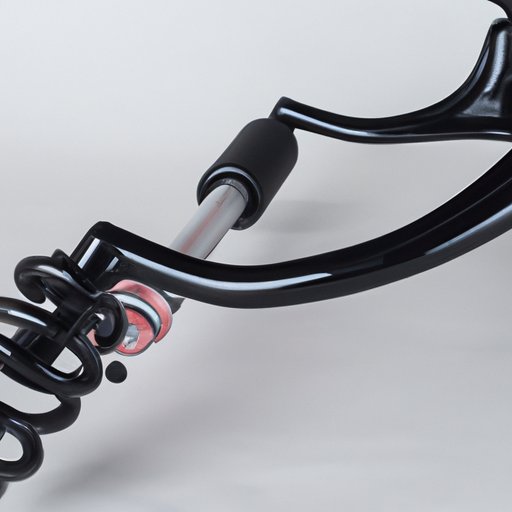Introduction
A sway bar, also known as an anti-roll bar, is a component of a vehicle’s suspension system that helps reduce body roll and improve handling. It is designed to increase the stiffness of a vehicle’s suspension by connecting the left and right sides of the suspension together. This connection helps prevent the body from leaning too far in one direction when turning or cornering, which increases the overall stability of the vehicle.
Exploring the Mechanics of a Sway Bar: A Breakdown of How It Works
A sway bar consists of several components, including two end links, a center link, bushings, and a metal bar. The end links are connected to the suspension arms on either side of the vehicle, while the center link is connected to the chassis. The metal bar runs between the end links and the center link, allowing them to pivot relative to one another. When the vehicle turns or corners, the metal bar rotates, transferring force from one side of the vehicle to the other. This helps reduce body roll and improves handling.
In addition to reducing body roll, a sway bar can also improve traction and braking performance. By connecting the left and right sides of the suspension, the sway bar limits the amount of movement of each wheel, which helps maintain traction and reduces the likelihood of wheel slip. This increased traction can also improve braking performance, as it helps ensure that the brakes are able to grip the road surface more effectively.

Understanding Vehicle Stability: How a Sway Bar Keeps You Safe on the Road
Sway bars are essential for improving vehicle stability, particularly when cornering or taking sharp turns. When the vehicle enters a turn, the weight of the car shifts to the outside wheels. This causes the inside wheels to lift off the ground, resulting in a loss of traction and an increased risk of skidding or spinning out. A sway bar helps to reduce this effect by evenly distributing the load across all four wheels, which helps keep the vehicle stable and prevents it from losing control.
In order to maximize vehicle stability, it is important to install and maintain a sway bar properly. If the sway bar is not correctly mounted, it can cause excessive wear and tear on the suspension components, resulting in decreased performance and increased risk of failure. Additionally, if the sway bar is not of the correct size for the vehicle, it can cause the vehicle to be unstable, resulting in poor handling and an increased risk of accidents.

Improve Your Ride Quality: Learn How a Sway Bar Improves Handling
A sway bar can also have a significant impact on a vehicle’s handling characteristics. By limiting the amount of body roll, a sway bar helps to maintain the suspension geometry, which improves the response time of the vehicle when cornering. This improved response time allows the driver to make sharper turns with greater control, which can improve the overall driving experience.
In addition to improved response time, a sway bar can also reduce understeer. Understeer occurs when the front wheels lose grip and the vehicle begins to slide instead of turning. By reducing body roll, a sway bar helps to keep the tires firmly planted on the ground, which can reduce the chances of understeer and improve overall handling.
A Comprehensive Guide to Sway Bars: What They Are and How They Work
There are two main types of sway bars – front and rear. Front sway bars are designed to reduce body roll when cornering, while rear sway bars are designed to reduce oversteer. Oversteer occurs when the rear wheels begin to slide and the vehicle loses control. Rear sway bars help to reduce this effect by increasing the stiffness of the rear suspension.
Front sway bars are generally larger than rear sway bars, as they are responsible for most of the work when it comes to reducing body roll. However, both front and rear sway bars are important in maintaining proper suspension geometry and improving overall handling. It is important to choose the right size sway bar for your vehicle, as an incorrectly sized sway bar can reduce handling performance and increase the risk of accidents.

Unlocking the Secrets of Suspension: Exploring the Function of a Sway Bar
The relationship between a sway bar and suspension is an important one. A sway bar helps to maintain balance when cornering by reducing body roll and ensuring that the tires remain firmly planted on the ground. At the same time, it is important to ensure that the suspension geometry remains correct, as incorrect geometry can lead to reduced handling performance and an increased risk of accidents.
A properly maintained and installed sway bar is essential for maximizing the performance of a vehicle’s suspension system. By reducing body roll and improving handling, a sway bar can help keep you safe on the road and provide an enjoyable driving experience.
Conclusion
A sway bar is an important component of a vehicle’s suspension system. It helps to reduce body roll and improve handling, making it an essential part of any car’s safety equipment. By understanding how a sway bar works and how it affects vehicle stability, you can ensure that your vehicle is equipped with the best possible suspension system.
In conclusion, a sway bar is an important component of a vehicle’s suspension system. It helps to reduce body roll and improve handling, making it an essential part of any car’s safety equipment. With proper installation and maintenance, a sway bar can help you stay safe on the road and enjoy a better ride quality.
(Note: Is this article not meeting your expectations? Do you have knowledge or insights to share? Unlock new opportunities and expand your reach by joining our authors team. Click Registration to join us and share your expertise with our readers.)
